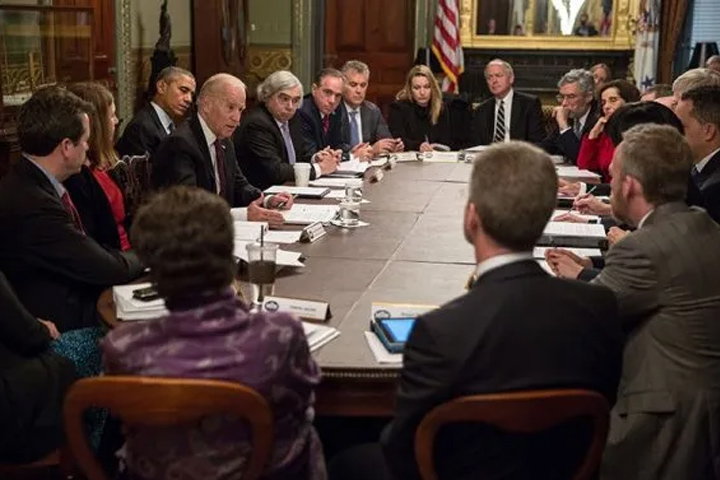The Cancer Moonshot

Pete Souza/Official White House photographer
Scientists are beginning to understand why a cure for cancer has been so elusive—and they’re learning how to stop the cancer process, at least in some cases.
At the helm of this effort: Vice President Joe Biden. He is spearheading a task force whose mission is to accelerate efforts to prevent, diagnose, and treat cancer and achieve a decade’s worth of progress in five years.
Last year, when Biden announced he was not going to run for president, he said “we need a moon shot in this country to cure cancer,” The term pays homage to President John F. Kennedy’s 1962 speech that convinced Americans that if we put in the effort, we could land on the moon. The Cancer Moonshot was officially announced at President Barack Obama’s 2016 State of the Union speech.
To drive cancer research forward, Biden committed to give scientists at the National Institutes of Health the biggest budget they’ve had in more than a decade. Thought leaders from the private sector, too, are throwing their cash into the ring.
“Never before have so many government agencies come together with the private sector to tackle the challenges involved in advancing cancer research and treatment,” says Elizabeth M. Jaffee, M.D., Deputy Director of the Sidney Kimmel Comprehensive Cancer Center at Johns Hopkins (Baltimore, Maryland) and Co-Chair of the Vice President’s Blue Ribbon Panel of scientific experts.
Interestingly, pancreatic cancer is poised to take center stage in many of the research efforts that make up the Blue Ribbon Panel’s 10 recommendations. Why the focus on pancreatic cancer? In nearly every case, scientists’ starting points include two cancers that respond to therapies and two that do not. Not surprisingly, pancreatic cancer and brain cancer top the list of nonresponsive tumors.
A Technology Superhighway
Cancer Moonshot funding will enable a remarkable level of coordination among researchers, clinicians, and patients across the country and even around the world. This unique ecosystem will allow all cancer patients—pancreatic and otherwise—to enter their own data, learn about new treatments, and discover which clinical trials are available for their specific tumor type.
“Gathering this information in a linked network of databases will enable more precise knowledge about which treatments work, in whom, and for which types of cancer,” says Jaffee. As an added bonus, when patients provide their information, they’re automatically pre-registered for clinical trials. So, when a patient’s tumor characteristics make them eligible to participate in new clinical trials, the researcher will be able to notify them (or their physicians) directly.
Physicians, too, will have access to information to help guide treatment decisions. And researchers will be able to identify possible targets for new treatments and preventive interventions.
Targeted Therapies
As part of the Moonshot initiative, researchers are striving to understand why some cancers are sensitive to targeted therapies and immunotherapies and others aren’t. They aim to discover new immune targets and evaluate immune-based approaches to increase cure rates in cancer patients—and eventually develop vaccines to prevent the disease from occurring in the first place.
While these efforts are aimed at all cancers, pancreatic cancer is a front-runner for the initial trials. The logistics are complex. Researchers have to map the range of genetic, molecular, cellular and physiologic mechanisms that not only lead to cancer development, but also which characteristics cause cancer cells to become resistant to treatment.
“This approach involves going back to archived cancer specimens and uncovering which treatments patients received and how effective they were, along with following patients as they undergo new treatment protocols,” explains Jaffee. But the results will be worth the effort. A growing national database will allow researchers to investigate more cancers for responsiveness and resistance while also identifying new targets for treatment.
Vice President Biden’s Cancer Moonshot Task Force launched a series of initiatives in 2016 and developed plans to serve as a “blueprint” for future administrations. By creating new paradigms for generating, sharing, and integrating research efforts, the Cancer Moonshot plans to accelerate the delivery of effective cancer prevention strategies, diagnostics, and treatments to patients’ bedsides. Strategic goals include:
- Foster scientific breakthroughs to uncover the biological mechanisms that underlie the onset of cancer and its treatment.
- Unleash the power of data to enhance, improve, and inform the journey of every cancer patient.
- Accelerate the process of bringing new therapies to patients’ bedsides.
- Strengthen prevention and diagnosis efforts.
- Improve patient access to quality care before, during, and after cancer treatment.
What’s Next
The Cancer Moonshot is designed to advance knowledge about all types of cancer and ultimately end cancer as we know it. But Americans need to step up to the plate, too, not only in terms of raising funds for research, but also by taking steps to prevent the disease from taking hold.
Reducing cancer mortality is about understanding your risk—and it’s about getting appropriate screening exams so doctors can catch cancers early when the chance of a cure is greatest. For now, Jaffee encourages people to review the Blue Ribbon Panel’s recommendations and get involved.
“Everyone on this project is accessible and available to discuss Americans’ concerns, thoughts and suggestions,” says Jaffee. “This is a national effort and we want everyone to win!”





